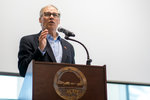



Gov. Jay Inslee visited Lewis County on Thursday to get a sense of local flood prevention measures currently taking place to reduce the impacts of flooding in the Chehalis River Basin.
His visit preceded the release of the state Department of Ecology’s final programmatic Environmental Impact Statement on a number of alternatives for reducing flood damage and restoring aquatic habitat.
“My two messages are this is a remarkable accomplishment that has been achieved already and it’s resulted in an unprecedented level of state support,” Inslee told a group gathered at the Adna Grange. “… It’s not a small effort, and it’s happened because of the recognition of that level of cooperation, but I just want everybody to know that whatever we’ve been able to do, we have two or three times as much more work we have to do individually to reach a joint successful effort to deal with both flood and aquatic species.”
The work to address flooding and aquatic species in the Chehalis Basin is something Gov. Inslee said he would continue to support.
“I think the urgency of our mutual work will become more urgent in decades to come because we are experiencing more extreme precipitation events,” he said. “The science is pretty clear that we will have an increase in the rate of extreme precipitation events in Western Washington, and so the work that we know is vital 20 years ago is going to be more vital 50 years from now, and that’s why I appreciate everyone’s work here.”
His visit took place at the same time as President Donald Trump announced the nation’s withdrawal from the Paris Climate Accord, cutting the governor’s tour short as he left to engage in discussions with other leaders on the move.
“There’s a certain irony to our discussion here because the president just announced that our nation is not going to move forward with dealing with climate change which is causing more precipitation events,” Inslee said.
After cutting one stop from his tour, Inslee spoke at the Center of Excellence for Clean Energy’s annual Energy and Construction Best Practices Summit at Centralia College.
There, he again touched on the impacts of withdrawing from the Paris agreement, but said the work currently being done will allow future generations in Washington to combat climate change in a different manner.
“If we give our people training, if we give them apprenticeships, if we give them an entrepreneurial opportunity, they are going to build a whole new clean energy economy in the United States and that starts right here where we have colleges training people in a variety of clean energy mechanisms,” Inslee said.
He spoke about a public-private partnership launched Friday that aims to have 100,000 high school students in the next five years be career ready after completing apprenticeships.
The governor’s day started in Centralia where Inslee received a tour of flood-prone areas, with a focus on the city’s efforts to help address the issues.
Emil Pierson, community development director of Centralia, provided a tour of areas in Centralia impacted by flooding throughout the years, many of which land in low income areas. He informed the governor of the city’s work to help address flooding by elevating buildings, and providing technical and financial assistance for flood-proofing projects.
Pierson said the city needs support from the state on its property protection program.
Gov. Inslee then had lunch at the Adna Grange with individuals who have worked on the flooding issues throughout the basin. There, attendees received a recap of the work currently happening as well as on the Programmatic EIS.
He then toured a dairy farm on Bunker Creek Road that utilizes critter pads to help protect livestock during flooding events. In the 2007 flood, John Brunoff lost 258 of his 272 cows. The critter pad will help ensure that will not happen again when another flood occurs.
Inslee said he would prefer to prevent the flood in the first place instead of losing another 1,700 head of livestock countywide like in the 2007 flood.
“We’d prefer not to have to depend on pads because the people with residential homes, they don’t have pads, so we have to solve this problem,” he said. “And the state is going to move forward in multiple ways.”